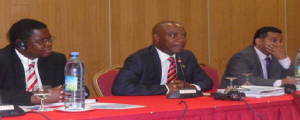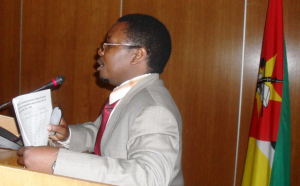Using Evidence as a Basis for Policy and Investment Decisions in Mozambique’s Agriculture Sector
The recent Mozambique National Policy Dialogue: Using Evidence as a Basis for Policy and Investment Decisions in Mozambique’s Agriculture Sector dialogue brought together high-ranking policy makers in the Government of Mozambique to discuss the findings and recommendations of the 2010 Annual Agricultural Sector trends and outlook report. It was facilitated by the Permanent Secretary for the Ministry of Planning and Development (MPD), Mr. Salim Valá and was officially opened and chaired by the Honorable Minister of Agriculture for Mozambique – Eng. José Pacheco. Mr. Victorino Xavier, the Director for MINAG/DE welcomed the participants and Dr. Pius Chilonda, the Head of IWMI-Southern Africa gave a keynote address.
Dr. Chilonda thanked MINAG/DE for the support and collaboration leading to the successful finalization of the 2010 Annual Trends and Outlook Report that was being launched at the dialogue and pointed out that this would be an annual flagship report produced by MINAG/DE as part of an on-going monitoring and evaluation (M&E) process for the agriculture sector in Mozambique. This report would be used to inform policy and investment decisions in the sector. Dr. Chilonda also thanked the Swedish International Development Agency (SIDA) for providing the funding for both phase 1 and 2 of the Mozambique Strategic Analysis and Knowledge Support System (MozSAKSS).

From left to right: Dr Pius Chilonda (Head-IWMI-SA), Hon Eng José Pacheco (Minister of Agriculture in Mozambique), and (Facilitator), Permanent Secretary (Ministry of Planning and Development)
The report presented key agricultural sector performance trends in Mozambique over the last decade (2000-2010). The performance trends tracked included: the macroeconomic environment in Mozambique, the current level of public investment in the agricultural sector, the current agricultural growth rates, the current agricultural trade performance, the current poverty and hunger outcomes, and the current progress made by Mozambique towards the attainment of the African Union’s (AU) Comprehensive Africa Agriculture Development Programme (CAADP) annual agricultural growth rate of 6%, the allocation of 10% of the national budget to agriculture annually (Maputo Declaration), and the halving of poverty and hunger by 2015 (MDG1).
Key Messages of National Dialogue:
1. Macroeconomic environment
In the period 2000-2010, there were huge fluctuations ranging from a minimum of 1% to a maximum of about 30% in values of year-to-year total and food inflation. The average total inflation was 11% and the average food inflation was 13%. The observed peaks in inflation reflect the effects of drought and floods on food availability and consequently high food prices. The troughs correspond to administrative controls in form of price subsidies. The total inflation in Mozambique is being mostly driven by food inflation which is closely linked to climatic conditions (i.e. floods and droughts) and external shocks. As such there is need to focus on strategies that will increase and stabilize agricultural output such as investing in technologies (e.g. irrigation) that will break the dependence on rain-fed agriculture. Reduced inflation will create a stable macroeconomic environment that is suitable for investment in agriculture and other sectors of the economy.
Overall, during the last decade there was no significant transformation in the structure of the economy in Mozambique. The average share in GDP for the service sector was 43%, followed by agriculture with 25% and manufacturing with 15%. This suggests that there is urgent need to diversify the structure of the economy by developing value chains as emphasized in Mozambique’s agriculture strategy (PEDSA) and CAADP to make the contribution of agriculture to other sectors more effective.

National Policy Dialogue participants with the FAO representative (first in front row from the right)

One of the 5 presenters: Eng. Adriano Chamusso (MINAG/DE)
2. Public agricultural spending
Over the last decade, Mozambique managed to attain the CAADP 10% allocation of the budget to agriculture in three years, namely 2003, 2004 and 2008. The average share of the budget allocated to agriculture was 7.3% a value which is about 3% below the CAADP target. This indicates that meeting the CAADP 10% allocation of the national budget to the agricultural sector still remains a challenge for Mozambique. In order to achieve the goals of improving agricultural growth, food security and attaining of the MDG1 there is need to accelerate CAADP implementation in Mozambique.
3. Agricultural productivity and growth
The agricultural data collection systems (TIA and EWS) currently present conflicting data an example is the case of cassava. Over the period 2005-2008, TIA data showed a declining trend and yet EWS data showed an upward trend. Hence there is need to harmonize these data sources for accurate evidence-based investment decision making in the agricultural sector.
Agricultural output (GDP) is dominated by crop production (78%), followed by forestry (9%), livestock (7%) and fisheries (6%), in that order as of 2009. The performance of agricultural subsector output in terms of attaining the CAADP 6 percent growth target, indicate that the crops subsector reached this target from 2005 to 2009, livestock only in 2005, fisheries in 2003 and from 2006 to 2008. Forestry, however, never attained 6 percent growth in the period under analysis. In general the average annual growth by agricultural subsector between 2001 and 2009 was 3.7 percent for crops subsector, 2 percent for livestock and about 1.7 percent for forestry and fisheries subsectors. In summary, in the last decade, none of the agricultural subsectors as well as the agricultural sector as a whole in Mozambique attained average annual growth target of 6 percent for agricultural GDP. Thus, more agricultural investment is needed in Mozambique in order to raise the agricultural growth rates of the various subsectors to the target of 6 percent, which is necessary for improved food security, and reduction of poverty and hunger in the country. The investments should aim at alleviating the constraints affecting productivity in each of the subsectors.
For the crop subsector, crop productivity has remained low because of the low uptake of modern technologies (5-10% of farmers use improved seed, 5% use fertiliser, average fertiliser use in 2008 was 5.3Kg/ha and 10% use animal traction) due to limited access to financial incentives, and poor access to output markets and value chains. As long as value chains, especially for food crops, remain underdeveloped, farmers will continue to use rudimentary production practices.
In fishing, crustaceans now lag behind sea fish in terms of economic importance. Harvesting of prawns has declined due to closure of fishing at a time when sea fish harvests have increased. The fisheries resource is potentially in need of improved management methods to sustain production.
As for livestock, the population of cattle has grown consistently throughout the period under review but the herd size of small ruminants, chickens and pigs declined. Livestock restocking programmes only benefitted cattle herders. Restocking of small ruminants did not attract the same response as that seen in cattle restocking. Beef and poultry provide more than 80 percent of the meat supply to formal outlets. Pork and meat from small ruminants play a minor role. More investment in animal health (vaccinations), improved management practices, improved breeds and livestock feeds and development of livestock value chains is needed to overcome the challenges affecting livestock production in Mozambique.
4. Poverty and hunger outcomes
Regarding progress made by Mozambique towards attaining the MDG1 targets of halving hunger and poverty by 2015, there was tremendous decline in poverty rates from 69 percent in 1997 to 54 percent in 2003 but from 2003 to 2009 poverty rates remained almost unchanged. However, if the current overall economic growth rates (above 7%) and agriculture growth rates (above 6%) are sustained, the country still has a chance of meeting the target of reducing the poverty rate to 40% by 2015 as targeted under MDG1. Progress towards halving of hunger by 2015, using prevalence of child malnutrition as an indicator of hunger showed a slight declining trend from 2003 to 2008. Mozambique stands a chance of meeting the target of reducing the 2008 chronic malnutrition rate of 44% at national level to 30% by 2015. The attainment of these MDG1 targets however can be derailed by greater vulnerability of smallholder farmers to adverse climatic conditions such as floods and droughts. In this regard, the government should take measures to provide social protection to the affected households.
The trend and outlook report was launched as an annual flagship report to be produced every year in order to inform policy and investment decisions in the Mozambican agricultural sector.
Key Outcomes of the National Dialogue:
1) The government of Mozambique and the key stakeholders in the Agriculture sector appreciated the current level of performance of the sector, the key challenges and the key opportunities for accelerating growth is the sector in order to ensure food security and poverty reduction
2) Evidence-based recommendations and strategic options for increasing investment in the agriculture emerged – for consideration by government, private sector, development partners and all key stakeholders
3) The key stakeholders in the agricultural sector exchanged knowledge and experiences on the future of agriculture in Mozambique.
The Trends and Outlook Report was launched as an annual flagship report to be produced every year in order to inform policy and investment decisions in the Mozambican agricultural sector.
View presentations from the National Dialogue:
- Budget and expenditure, "Despesas Públicas na Agricultura," (Portuguese) - Adriano Chamusso
- Agricultural Sector Development, The Macroeconomic Environment" - Precious Zikhali
- Avaliaçao do Desempenho do Sector Agrario (2000-2009) - Helder Gemo
- Trends of Agricultural Production, Technology Adoption and Trade - Jones Govereh
- Agricultural trends in Southern Africa - Dr. Emmanuel Musaba.
For more information please contact Emmanual Musaba of ReSAKSS-Southern Africa at E.Musaba@cgiar.org.


